Art History
Decoding the Nebra Sky Disc, an Ancient Vision of the Cosmos
This year marks the 25th anniversary of the disc's discovery by treasure hunters in Nebra, Germany, in 1999.
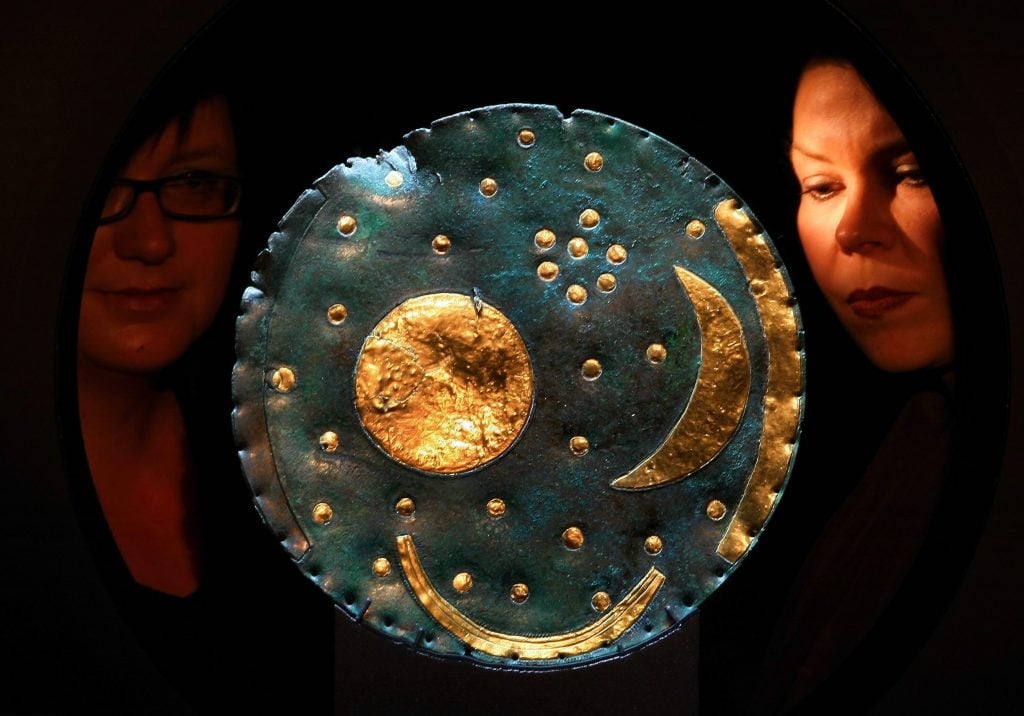
In July 1999, under the cover of darkness, two amateur treasure hunters with metal detectors unearthed a mysterious, ancient disc on a hillside near the town of Nebra, Germany. The two men knew they’d found something—an enigmatic circle of corroded bronze measuring 12 inches across and adorned with gold shapes—which they’d excavated with two swords, among other artifacts. But the duo certainly didn’t grasp the magnitude of their discovery.
The artifact, known today as the Nebra Sky Disc, held an ancient depiction of the cosmos, featuring a sun and moon or the moon in two lunar phases, along with a smattering of stars. The object had been buried in the earth for millennia by the time it was uncovered haphazardly in contemporary Germany. Dated by most to the Bronze Age, the Nebra Sky Disc is the oldest-known depiction of the cosmos.
Today, a jewel of the collection of the State Museum of Prehistory in Halle, Saxony-Anhalt, the Nebra Sky Disc is a treasure of Germany’s ancestral heritage and an enduring emblem of humanity’s age-old connection to the skies. But while the Nebra Sky Disc is an unparalleled treasure of the ancient world, it is also shrouded in great mystery and controversy. Archeologists have debated everything from just what it depicts to its true age.
Unfortunately, many of these confusions were born from the disc’s unorthodox discovery. The men who had uncovered the disc had done so illicitly (all artifacts in the region belong to the government) and they damaged the disc in the process, denting it, in several places. The suspect dealings of these treasure hunters have also stirred debate over the dating of the disc. While the majority of leading scientists and archaeologists believe the disc dates to the Bronze Age (making it approximately 3,600 years old, based on dirt found on a sword that was exhumed alongside it). Others argue that the disc is in fact a thousand years younger, dating to the Iron Age, based on its iconography, and suspect that the two men who uncovered the disc, ultimately misled the authorities to make the object appear older (hence more valuable).
Suffice it to say, the Nebra Star Disc has stirred the deep passions of stargazers and scientists alike. Ahead of the 25th anniversary of its rediscovery, we’ve found three facts that offer new insights into this singular object.
1. It Was Made Over Generations and Likely Buried in a Ceremonial Process
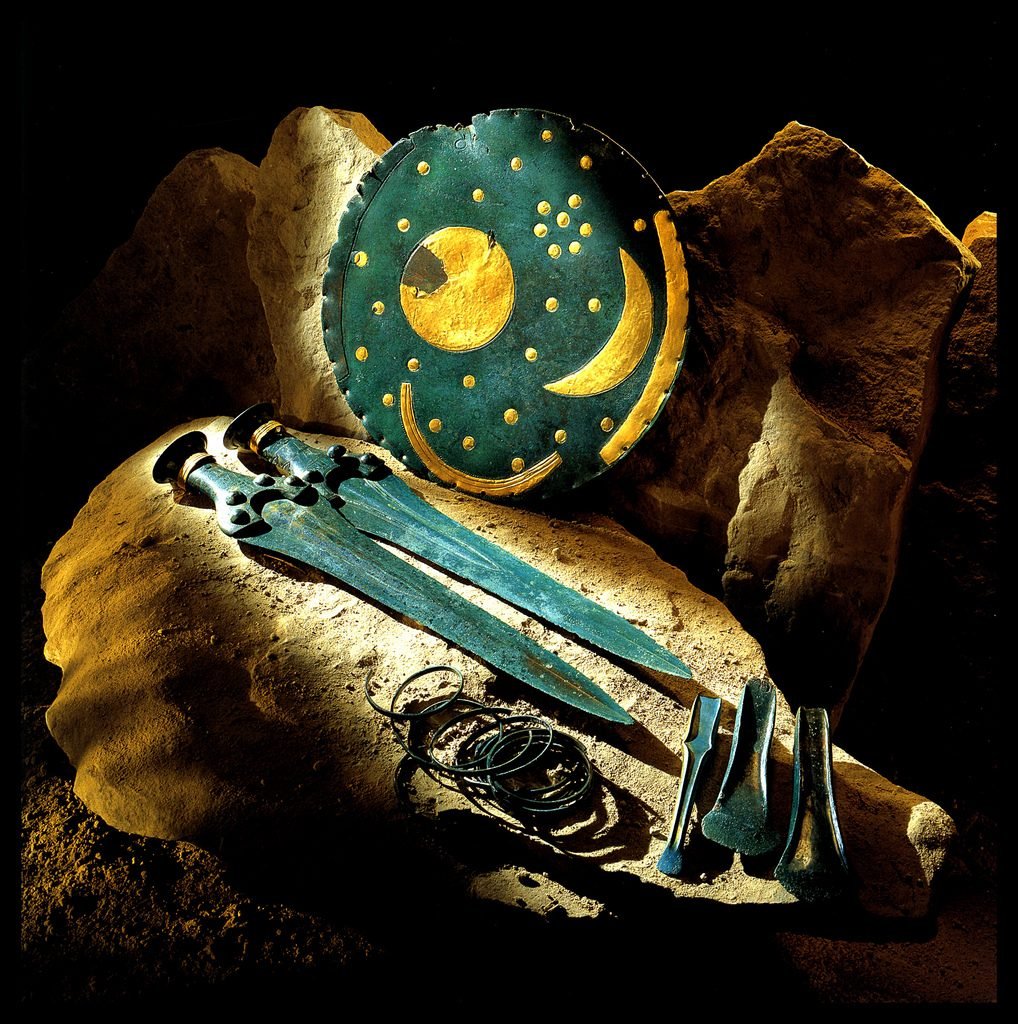
The controversial Nebra Sky Disk and some of the Bronze Age artifacts with which it was found. Photo courtesy of the State Museum for Prehistory in Halle, Germany.
The Nebra Sky Disc, whatever its original purpose, was significant to its society. Dating and analysis of the disc suggest that it was constructed in stages, with new details added over generations. The disc is made from copper, tin, and gold—materials whose origins have been traced to Cornwall, England. The rich blue-green patina of the bronze of the disc today occurred from chemical changes over time. Originally, it would have been a deep bronze hue. Over the years, facets were added and removed presumably as new observations were made. For instance, certain gold circles representing stars (32 are visible today) were added, while others were obscured. Archaeologists believe the Nebra Sky Disc was made in four distinct stages. Ultimately, it was buried, likely with a ritual intent, perhaps as an offering to the gods. “We see this actually quite a lot in the Bronze Age, these so-called depositions, or ‘hoards of bronzes,’” said Maikel Kuijpers, an assistant professor in European prehistory at Leiden University, in a 2021 interview in the New York Times.
2. The Disc May Reference Egyptian Mythology
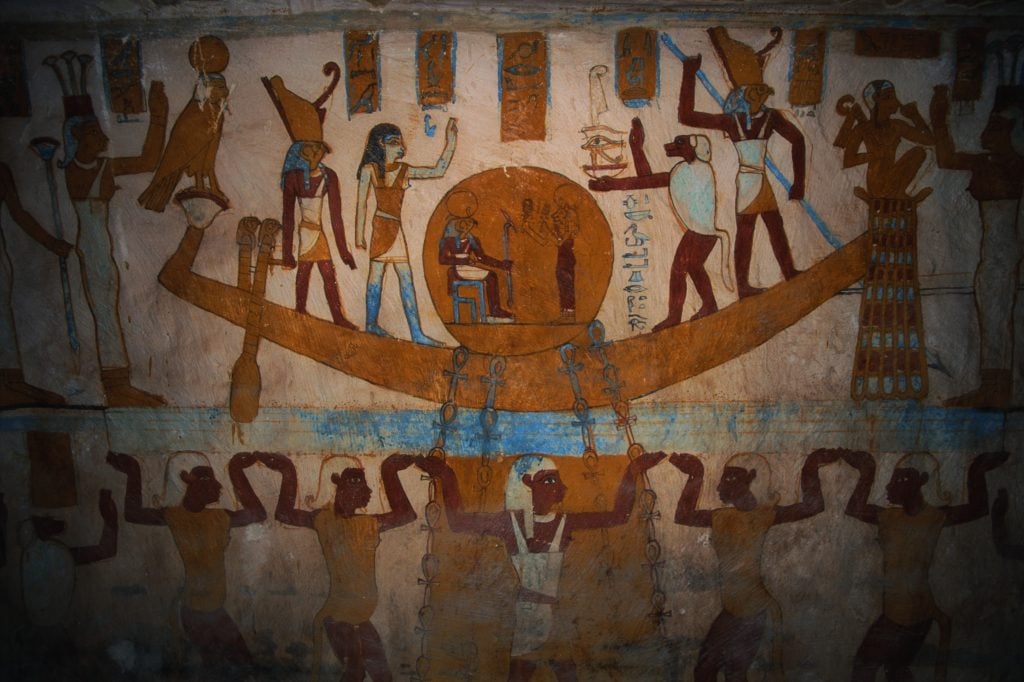
Mural Painting in Tomb of Bannantiu Depicting Solar Barque with Egyptian Gods and Goddesses. Photo by Ron Watts/CORBIS/Corbis via Getty Images.
Look closely at the disc. The two large central shapes are thought to represent either the sun and a crescent moon, or two lunar phases, full and crescent. A gold band appears on one side of the disc, juxtaposed by an etched curve on the other. These adornments are thought to mark the horizons of the rising and setting suns or to mark the angle between the solstices. One detail of particular fascination is a gold curve that bends to form a soft “u” shape below the sun and moon forms.
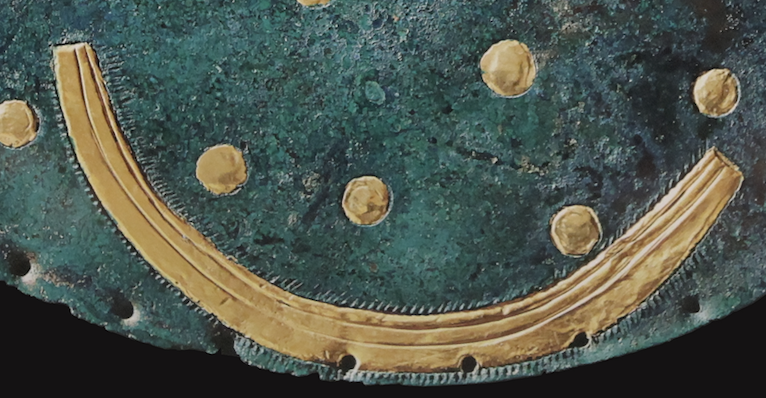
Detail of the Nebra Sky Disc.
Examined closely, one notices many small lines are incised off of its shape. Many archaeologists believe that this form represents a solar barque—an Egyptian mythological vessel that symbolized the passage of the sun through the day and night. The small incisions represent numerous oars. The solar barque would both emphasize the disc’s religious significance and underscore the migration of Egyptian ideas and culture through Northern Europe. This would not be wholly novel; representations of the solar barque have been found as far north as Scandinavia.
3. The Pleiades Star Cluster Appears—Perhaps as a Guide to Harvesting
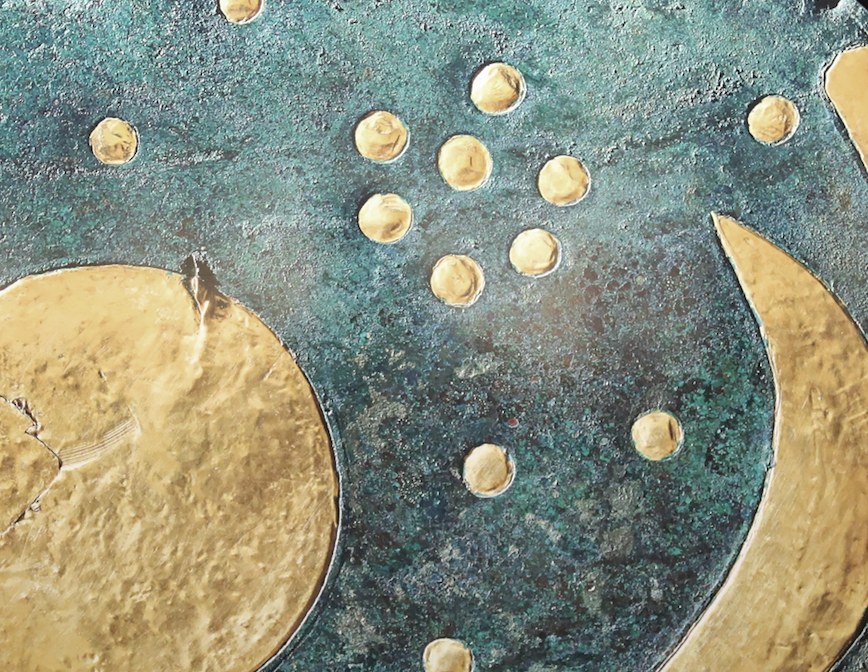
Detail of the Nebra Sky Disc.
Notice the grouping of stars hovering above and between the sun and moon forms? Many archeologists believe this represents the “Seven Sisters” or Pleiades star cluster. This star cluster is visible from both hemispheres. Its positioning may have been used as a guide for harvesting.
This reading is supported by the writings of Greek poet Hesiod, circa 700 B.C.E.: “When the Pleiades, daughters of Atlas, are rising, begin your harvest, and your ploughing when they are going to set. Forty nights and days they are hidden and appear again as the year moves round, when first you sharpen your sickle. This is the law of the plains, and of those who live near the sea, and who inhabit rich country, the glens and hollows far from the tossing sea,—strip to sow and strip to plough and strip to reap, if you wish to get in all Demeter’s fruits in due season, and that each kind may grow in its season.” This interpretation has led some to believe that the gold curve (typically read as the solar barque) could instead represent a sickle.





